“Her very name evokes images of beauty and sensuality, yet when we look for this creature in the New Testament, we look for her in vain.”
–Susan Haskins, Mary Magdalene: Myth and Metaphor
Who is Mary Magdalene to you? Apostle or icon of penitence?
The Feast Day of Mary Magdalene is on July 22. In 2016, Pope Francis elevated her memorial day from a celebration to a Feast. He wrote, “Saint Mary Magdalene is an example of a true and authentic evangeliser.” In the Eastern Orthodox church, she is “the apostle to the apostles” as one of the first women to witness and announce Jesus’ resurrection to the male disciples.
Yet even with such official praise, and sainthood as well, Mary Magdalene’s name is still tainted with a past that likely did not exist. Western (but not Eastern) church tradition holds she was a prostitute, and that is why she had seven demons cast out of her (Luke 8:2). For centuries, artists celebrated her as the epitome of the repentant sinner, but often painted semi-nude.
However, neither Scripture nor the early church fathers reveal such an image. Scholar James D. Tabor writes, “It was Pope Gregory the Great (540-604 CE) who sealed her fate. He conflated John’s story of Mary of Bethany [who anointed Jesus] with the sinful woman who anoints Jesus in Luke, and declared both women were Mary Magdalene.”
I’d like to whittle our impression of Mary Magdalene down to the New Testament Scriptures (read them here). Below are some assertions based on the gospels.
Diakonoi (Ministers) of Jesus and the Twelve
Mary was wealthy, probably single, and willing to travel with and financially support Jesus’ entourage. She may have been from the city of Magdala, a “prosperous fishing village.” Luke 8:1-3 is a phenomenal text as far as understanding Jesus’ attitude toward women, including Mary Magdalene. Here it is:
Soon afterwards he went on through cities and villages, proclaiming and bringing the good news of the kingdom of God. The twelve were with him, as well as some women who had been cured of evil spirits and infirmities: Mary, called Magdalene, from whom seven demons had gone out, and Joanna, the wife of Herod’s steward Chuza, and Susanna, and many others, who provided for them out of their resources.
For context, good Jewish women did not talk to men in public, and vice verse. They were certainly not to travel with men without their husbands or as singles, or to follow rabbis. Yet Jesus ignores these cultural and religious restrictions for the sake of the good news. He applies his words equally to all.
He and his male followers chose to be supported by this group of powerful believing women. (One can only imagine how the male disciples actually felt about this!). The Greek says the women “were ministering” [diekonoun] to Jesus and The Twelve. The first named is Mary Magdalene.
Troubled, not Loose
Jesus had cured her of demon possession (Mark 16:9; Luke 8:2). It likely happened in a rather dramatic way, since it was possible to count the number of demons that left. Her exorcism was memorable and notable to both Mark and Luke.
But that is all we know about Mary’s inner life or history before meeting Jesus. There is not a single reference to her sexual behavior. It’s important also to note that Mary’s wealth precluded the financial need for prostitution.
Many have confused the unnamed “sinful” woman of Luke 7 with Mary Magdalene, because Luke names Mary in 8:1-3. Yet, even the unnamed Luke 7 woman is not likely a sexual sinner. (See my argument here).
She Knew Him Well
What we know best is that Mary Magdalene was close to Jesus, as follower and friend. She stayed with him as a family member, standing at the cross with Jesus’ mother and aunt (John 19:25). Her commitment to even His dead and battered body (Mark 15:47; Mt. 27:61; Mark 16:1) led to her being the first, among other women, to see the risen Christ.
The scene in the garden elicits an intimacy based merely on the voice of Jesus saying her name, “Mary” (John 20:16). It is this personal word that enables her to see and believe the impossible: Christ resurrected. Her love for him compels her to reach out and hold him upon recognizing him (John 20:17), her joy causing her to bypass all cultural rules about women touching men.
Centuries later Mary would be called “the apostle to the apostles” due to Jesus’ admonition to her to tell the male disciples that He had risen (Luke 24:1-11; John 20:17). And so she is rightly celebrated on her own Feast Day as a disciple and an apostle, and not as a penitent prostitute. In the restoring of her reputation, women and men together win a saint and lose a stereotype. As scholar Susan Haskins concluded, “In losing the myth of Mary Magdalene…has not our culture…everything to gain?”
***************
For fascinating reading about Mary Magdalene in light of archaeological evidence, check out scholar James Tabor’s four-part series on her.
Also recommended:
Mary Magdalen: Myth and Metaphor by Susan Haskins
The Gospel of Mary of Magdala: Jesus and the First Woman Apostle by Karen L. King

